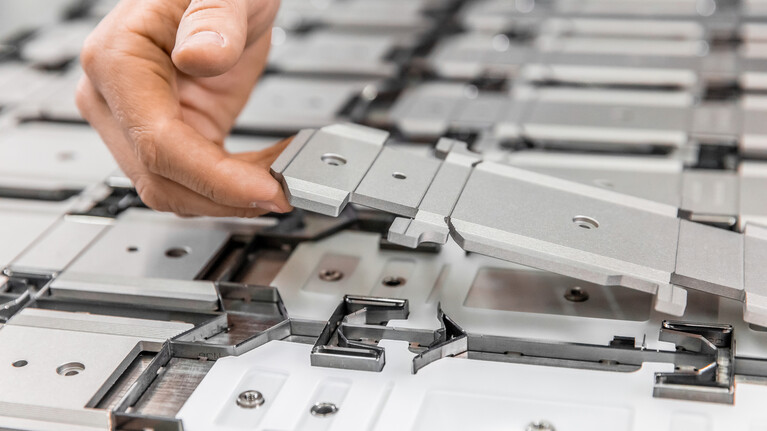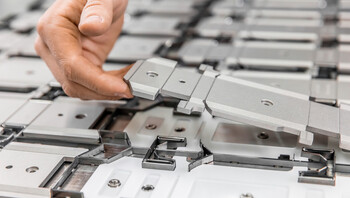100 years
Marbach Group
21. April 2023
100 years of Marbach (Part 5) Technologies, innovations and patents: Marbach sets market standards.
Almost 100 years ago, the Marbach Group was founded as a small craft business. Today, we are a firmly established player in the packaging industry. Over the years, Marbach has brought numerous technologies and innovations to the market, many of which have become standard in the industry. These include technologies and products such as rillma, mpower, marbastrip, the crease-plate-die or the greenplate, which have been successfully on the market for many years. But also, solutions of the latest generation like the DZL|plate or CONNECT|M. The name Marbach is all about a highly innovative company that regularly registers patents and sets market standards.
One of the great talents of Karl Marbach Junior was to identify useful technological innovations for Marbach: in 1967, for example, he took over the license for the production of rillma matrixes. Until then, thin pressboard was glued to a cutting plate as counter plates. In the machine, an impression of the cutting-die was made with the help of carbon paper, and the impressions of the cutting and creasing rules were milled and beveled. Operations that were performed by the printer were very time consuming: It took a print shop 1.5 working days.
With rillma, Marbach was now able to offer its customers not only the cutting-die but also the matching counter plate. And this with a previously unknown accuracy. This became more and more important in the 1960s, as self-service stores emerged and packaging manufacturers such as Höhing, Landerer or Schilling settled in the Heilbronn region – because of the Knorr company.
At the beginning, the manufacturing process of rillma and the cutting of the channels was quite labor intensive. However, new xy-milling machines with guidance quickly brought about a breakthrough. Marbach also developed a rillma machine consisting of a vacuum clamping plate with 2 axes and a frame with air motors.
mpower cutting rule and package
In 1996, Marbach launched a completely new patented technology under the name mpower, which was to revolutionize die-cutting technology and set a new market standard. The special feature of the mpower cutting rule developed by Marbach was its rounded cutting tip. This had a significantly higher pressure load capacity than conventional cutting rules and was therefore characterized by its long service life. But not only that, due to its special cutting geometry, the start-up curve was significantly improved so that it was immediately in the optimum state for the die-cutting process. In combination with other components such as special machining and assembly techniques as well as zone levelling, the mpower rule drastically reduced knife patching times. mpower was then, and still is today, an important asset for productivity in the die-cutting process.
As a further development of the mpower technology, the so-called mpower+ package followed in 2012. In addition to a revised cutting rule, mpower+ includes a laser cutting process developed specifically for this technology, a special assembly technique, special rubbering, and the specification of the calculated starting tonnage and expected cutting pressure. This makes it possible to reduce the knife make-ready times even further.
marbastrip stripping technology
The marbastrip stripping claws, developed by Marbach, were patented in 1991 and are still the market standard today. With them, the time-consuming setting of lower pins is no longer necessary. marbastrip stripping tools stand for dynamic stripping, in which the waste parts are held with the help of the claws and pressed through the tool so that they spray away from the sheet.
The masterstrip|plate is a further development of this technology. This was released by Marbach in 2009. The male stripper is equipped with a presser plate and special sheet lifters. The presser plate fixes the waste securely and evenly during the stripping process. The sheet lifters, marbafly for short, support the smooth onward transport of the paperboard sheet.
High-tech cutting-die crease-plate-die
The crease-plate-die was developed in 1999 and is used for very long runs where highest demands are placed on the creasing results. This is mainly in the tobacco and beverage sectors. But it is also used for packaging where creases need to have very low restoring forces, because CNC-milled crease plates are extremely precise. Based on this technology, Marbach launched the two technologies crease-plate-die|+ and crease-plate-die|rc in 2020/2021. The latter is specially designed for use with round corner packaging.
Digital zone levelling DZL|plate
Every die-cutting machine is subject to wear in the daily production process. For this reason, it was previously necessary to fill in the worn zones with make-ready paper when setting up each individual cutting-die. This cost time and money for each tool. Because during this process the machine stands idle. This changed suddenly with the DZL|plate from Marbach in 2016: with this, zone levelling only has to be carried out once. This then lasts for several months. And for every tool that is used on the machine.
Marbach is breaking new ground today with its digital system solution CONNECT|M. This connects machine, tools and user. CONNECT|M makes it possible to collect performance data in packaging production automatically and digitally in real time. For maximum performance and smooth processes.
Use of pioneering technologies
But it is not only Marbach's own developments and patents that have made the company the innovation leader it is today. The company has always been open to new technologies and managed to utilize many innovations from other industries for its own purposes.
In the late 1920s, for example, steel rule technology was still completely new and Marbach was one of the first companies in this country to decide to build cutting-dies. (More about this in the first part of this series: "100 Years Marbach. 1923 - 1927: The founding years.") At the end of the 1950s, the still young company expanded to include its own toolmaking department, which produced the first thermoforming mould and cutting-die in 1960. Today, the company which emerged, Marbach Werkzeugbau GmbH, produces thermoforming tools for the plastics industry, and is an important pillar of the Marbach Group. In 1968, Marbach established the "rotary cutting-die" division for the corrugated board industry and was one of the first companies to produce such rotary dies.
In the early 1970s, Karl Marbach Junior risked much by deciding to invest in a CO2 laser system. (Read more in part 4 of this series: "100 years of Marbach. A major milestone: the use of laser systems in die-cutting technology.") This decision was groundbreaking for the entire die-cutting technology in Europe. At the end of the 1970s, Karl Marbach again decided for the right technology: BASF's new development Nyloprint, which was state-of-the-art at that time. What was revolutionary about the use of Nyloprint was that the counter plate could now – with the help of the Nyloprint system at Marbach – be produced outside the die-cutting machine, thus saving the customer valuable set-up time. In addition to the use of the material in the creasing matrix, Nyloprint was also used by Marbach as an embossing material. The use of this new technology not only brought economic advantages but also attracted the later Managing Director of die-cutting technology, Franz Strack, to Marbach. He was eager to join Marbach because the company was clearly innovative and willing to invest in the latest technologies.
In 1985, the introduction of Computer Aided Design (CAD) fundamentally changed production at Marbach. Orders could now be processed in a fraction of the time previously required. In 1990, the first waterjet cutting system designed and produced by Marbach was installed in Heilbronn to cut duramar dieboards. Only a few years later, Marbach started the production of the first cutting segments for rotary solid steel tools, mainly for the cigarette industry. Besides the continuous refinement of products, machines and production processes, Marbach also pursued organizational optimization. Therefore, Karl Marbach introduced a quality management system in 1994 and the company was then certified according to DIN EN ISO 9001. Four years later, the certificate was renewed and was now also valid for tool making. Subsidiaries followed this example and also received the DIN EN ISO 9001 certificate.
In the new millennium, many innovations and new product launches followed. The list is long: embossing dies and hotfoiling, digital zone levelling, which has been saving make-ready time in zone levelling since 2016, and investment in a die-cutting machine and thermoforming machines for training and testing purposes. And the list is getting longer all the time. With the CONNECT|M technology, Marbach is embarking on Industry 4.0 both in die-cutting technology and in tool making. One can only be curious about which innovative products, technologies and services the company will introduce in the future.
In addition to innovations and market standards, there have been other important milestones in the Marbach Group: You can read which anniversaries Marbach celebrated in part six of this series: "100 years of Marbach. The anniversaries."

